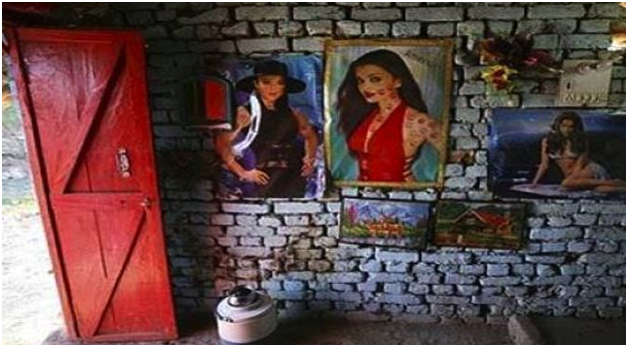Roadside Brothels Ensnare Bedia Daughters

The choice has been made and the community celebrates it-- this is her non-wedding night.
Not more than 30 miles west from the symbol of love and devotion, the famous Taj Mahal, towards the road to Jaipur, one can spot two an 15- year-old girl, sitting by the fire, subtly trying to catch the attention of the passer-bys.
Her heav make-up, striking face and beautiful rosy saris makes her look as if she were on her way to a party. But the truth is different. Raso, 15, is a virgin and a bidding war is being held for the right to be the first one to sleep with her.
The collection of shelters where she lives, houses 59 families, all members of the Bedia tribe, which has a long tradition of caste-based prostitution. The Bedia girls born here become prostitutes in a rite of passage into “adulthood” as routine as marriage is to the rest of Indian society. The ‘first time’ is a valued commodity for which the middle-class businessmen, who pass through this highway are prepared to pay a premium sum of money.
“The normal rate is 200 rupees but a virgin is sold to the highest bidder for anything over 20,000 rupees at least. If she is very pretty, the community would hope to get up to 40,000 rupees”, says Dayaprakash Yadav of Sodavas village in Behror, who worked in this locality with a NGO named Saamaj.
For this, “...the man can have access to the girl for as long as he likes, it can be several hours, days, or even weeks. When he get tired of her, there is a celebration”, he explains. Because it is considered unlucky for a girl to keep the money from her first time, “...it is spent instead on an extravagant party. Jewellery is bought for her and for her relatives, goats are slaughtered and alcohol runs freely. There is dancing, and offerings are made to the gods”, he concludes. Once a girl has lost her virginity, she cannot marry. The choice has been made and the community celebrates it - this is her non-wedding night.
Raso narrated that she was blissful to come into the trade. “I chose it,” she said, though she admitted being “a little” frightened. “I do not know how it is going to be. I know other girls who are in the trade but I have not asked them how it is.” She maintained that it did not matter what the customer looked like. “I will go with whoever pays the highest price,” she said, before running off as her mother called her for dinner.
Barfi, another virgin in the shed next door, has four sisters, all of whom are prostitutes. Their ages are between 14 to 19 years—who wear salwar suit but Barfi wears jeans and a skimpy top, and giggles a lot. She sings well, specially, songs Balam pichkari jo tunay aisi mari...and even songs from vulgar Bhojpuri films including Ragini songs. One sister swanks that as Barfi is particularly pretty, they hope to get 60,000 rupees. “We have been offered 45,000, but it is not adequate.” Among the Bedias, adolescent girls are initiated into the family ‘tradition’, while their brothers become ‘agents’. They may practice locally, on highways or in big cities such as Delhi and Mumbai as bar girls or in brothels. Marriage is rare for these girls, but once married, they aren’t permitted to take clients.
Lata is only 14 but has opted to follow her sisters route into the trade. It is her own “choice”,she says as she giggles, “I won’t have to do any housework.” But in avoiding regular chores like making chapatis, she has signed up to a life in which she will deal with 10 to 15 clients per day, until she reaches her forties. After that, when she is no longer considered desirable, she will depend on any children she may have for support. Three of her sisters, Reema, 38, and Kali, 29, have built one of the few stone houses in their village, for which they paid the equivalent of Rs. 3.0 lakh, and are proud of their success. “There was a lot of poverty, we had nothing to eat,” explained Reema. “What you see now has come with hard work.” They support 50 family members - 35 children and 15 adults.
Most of the Bedia girls earn between 1,500 and 2,000 rupees a day. But the ongoing construction work hampered their traditional way of life, which is called prostitution. These Bedias require shelters to make room, “We need a shelter by the road”. “Tell the government to build us somewhere we can work. We used to have 25 or 30 clients a day, now the average is 10 or 15.” They said they were able to keep their rates up because they could provide a nice room and running water for their clients, who are mostly married businessmen from Agra.
In the age of Beti Bachao, the prevalence of caste-based prostitution in certain tribes in the region, the Bawaria, Nuts, Bedias, Kanjars and Sansis, is getting more relevance for sustained livelihood. Due to hindrances like construction or widening of roads or rooting out the Bedias’ settlements beside the roads, the girls are migrating towards Delhi. “It came to light after a raid on a brothel in Delhi. Now an attempt is being made to break the cycle by which the girls of each generation enter the trade”, says Ratnveer Singh of Alwar.



